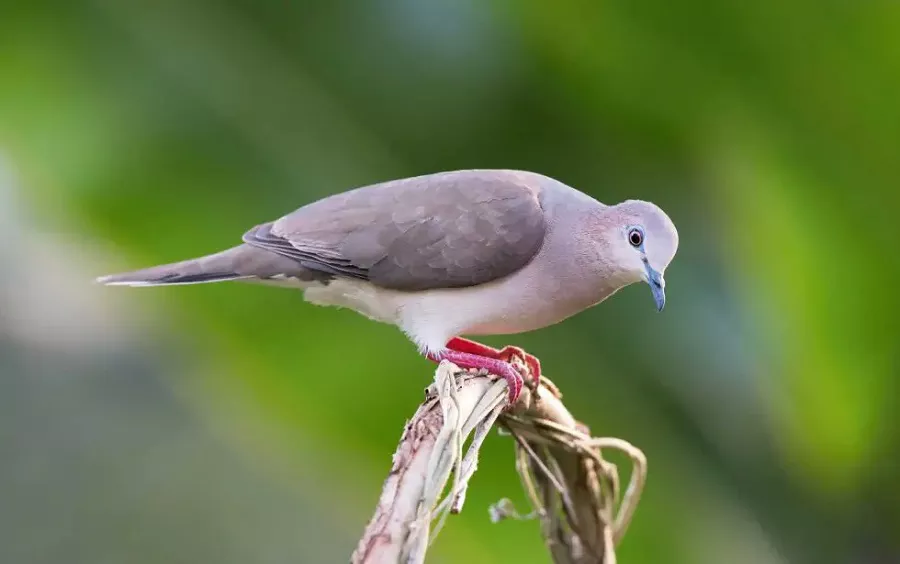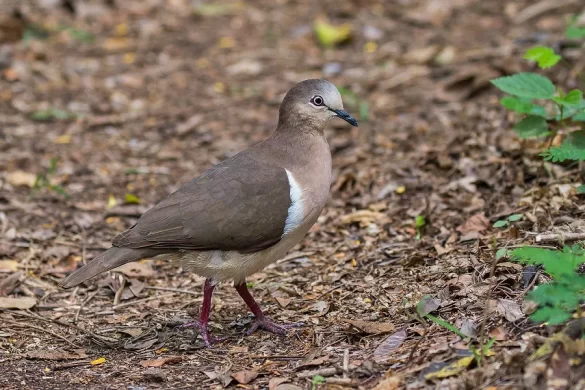The Grenada Dove (Leptotila wellsi), is found only on Grenada. Originally known as the Pea Dove or Well’s Dove, it is the National Bird of Grenada. It is considered to be one of the most critically endangered doves in the world (Bird Life International 2000). In this article, we delve into the significance of the Grenada dove, exploring its characteristics, habitat, conservation status, cultural importance, and ways to support its preservation.
Physical Description
The Grenada dove is a sight to behold, characterized by its elegant appearance and soft features. It measures approximately 31 centimeters in length, with a distinctively plump body and a slender neck. The Grenada Dove is characterised by a white throat; face and forehead pale pink shading to dull brown on crown and nape; upperparts olive brown; underwing chestnut; neck and upper breast pink-buff fading to white on lower breast, belly and undertail coverts.

Grenada dove
Habitat and Distribution
This exquisite bird finds solace in the lush, verdant landscapes of Grenada, favoring dense forests and wooded areas where it can seek shelter and forage for food. While its distribution was once widespread across the island, the Grenada dove now primarily inhabits the interior forests of the Grand Etang National Park and other protected areas. It is also known to frequent the slopes of Mount Hartman and the rainforests of the Grenadian mainland.
Despite its localized presence, the Grenada dove exhibits limited migratory patterns, preferring to establish stable territories within its preferred habitat throughout the year.
Conservation Status
The Grenada Dove is classified as critically endangered by the International Union for Conservation of Nature (IUCN), highlighting the urgent need for conservation action. Habitat destruction, caused by deforestation and urban development, poses a significant threat to the bird’s survival. Additionally, the introduction of invasive species such as mongooses and rats exacerbates predation pressure on the Grenada Dove population.
To address these challenges, conservation initiatives focus on habitat restoration, community engagement, and scientific research to better understand the dove’s ecology and behavior. By fostering partnerships between government agencies, non-profit organizations, and local communities, Grenada is striving to ensure a brighter future for its national bird and preserve its natural heritage for generations to come.
Cultural and Symbolic Importance
Beyond its biological significance, the Grenada Dove carries profound cultural and symbolic importance for the people of Grenada. Revered as a symbol of peace and resilience, the dove embodies the spirit of unity and harmony amidst diversity. Its presence in Grenada’s emblem reflects the nation’s aspirations for prosperity and tranquility.
Cultural Connection
Grenada’s folklore and traditions are deeply intertwined with the Grenada Dove. Legend has it that the dove is a guardian spirit, watching over the island and its inhabitants. Its soothing coo is believed to bring blessings and protection to those who hear it, a sentiment echoed in Grenadian folk songs and stories passed down through generations.
In Grenadian art and literature, the Grenada Dove often serves as a muse, inspiring poets, painters, and musicians alike. Its graceful presence symbolizes hope and resilience in the face of adversity, a motif evident in various artistic expressions across the island.
Visiting and Observing
For avid birdwatchers and nature enthusiasts, witnessing the beauty of the Grenada dove in its natural habitat is a rare and unforgettable experience. While sightings may be challenging due to the bird’s elusive nature, visitors can increase their chances by exploring protected areas such as Grand Etang National Park and Levera National Park.
It is essential to observe responsible tourism practices when seeking out the Grenada dove, respecting its habitat and maintaining a safe distance to minimize disturbance to these delicate creatures.
Some Interesting Facts About Grenada dove
The Grenada dove (Leptotila wellsi) is a critically endangered species of dove native to the island of Grenada in the Caribbean. Here are some interesting facts about this unique bird:
1. Endangered Status: The Grenada dove is one of the rarest doves in the world and is classified as critically endangered by the International Union for Conservation of Nature (IUCN). Its population has declined dramatically due to habitat loss and hunting.
2. Distinct Appearance: The Grenada dove is a beautiful bird with a unique appearance. It has a soft, pale gray plumage with a distinctive lilac wash on its head, neck, and breast. Its wings are marked with black and white spots, and it has bright red legs and feet.
3. Restricted Habitat: This species is endemic to Grenada, meaning it is found nowhere else in the world. It primarily inhabits the island’s dry forests and scrublands.
4. Mating Rituals: Grenada doves are known for their elaborate courtship displays. During mating season, males will perform a series of impressive aerial acrobatics, including steep dives and sharp turns, to attract females.
5. Low Reproductive Rate: Like many other doves, Grenada doves have a relatively low reproductive rate. They typically lay only one egg per nesting attempt, and the incubation period lasts around two weeks.
6. Conservation Efforts: The Mt. Hartman National Park was established by the Government of Grenada in 1996 to ensure the protection of the endemic Grenada Dove in one of the key habitats for the bird on the island. The National Park has been identified by BirdLife International as an Important Bird Area (IBA) for the Grenada Dove.
7. Symbol of Grenada: The Grenada dove holds cultural significance for the people of Grenada and is considered a national symbol. It is featured on the country’s coat of arms and is celebrated as a symbol of peace and environmental conservation.
8. Legal Protection: In Grenada, the Grenada dove is legally protected from hunting and trade under national laws.
Conclusion
In conclusion, the Grenada dove stands as a symbol of pride, resilience, and natural beauty for the people of Grenada. As we navigate the challenges of environmental conservation in the 21st century, it is imperative that we come together to protect and preserve this iconic species. By recognizing the cultural, ecological, and symbolic significance of the Grenada dove, we can pave the way for a sustainable future where this majestic bird continues to grace the skies of Grenada for generations to come.


 Facebook
Facebook  Instagram
Instagram  Youtube
Youtube 